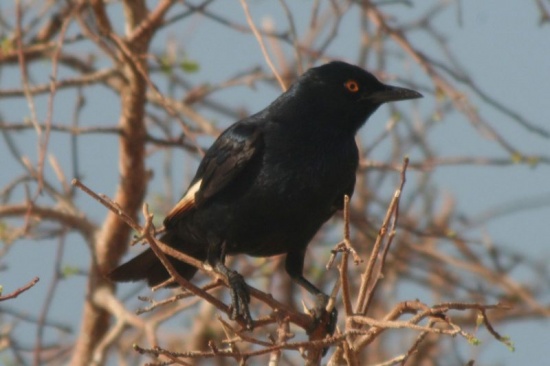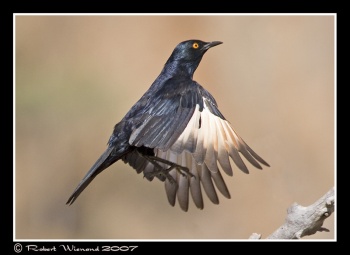- Onychognathus nabouroup
Identification
27cm.
- Uniformely glossy black plumage
- Pale rufous panel on wing (well visible in flight)
- Orange-yellow eye
- Black bill and legs
Sexes similar. Juveniles are less glossy than adults and have a brown eye.
Similar species
Has a shorter, squarer tail than Red-winged Starling. Note also the paler eye and the pale wing panels.
Distribution
Found in south-western Africa from southwest Angola to Namibia and the western interior of South Africa.
Common to abundant in parts of its range.
Taxonomy
This is a monotypic species.
The proposed subspecies benguellensis from Angola is usually not accepted.
Habitat
Rocky arid areas, also in towns. Occurs from sea-level up to 2000m.
Behaviour
Diet
Feeds on fruit and arthropods.
Usually foraging in pairs or small groups. May form flocks with Red-winged Starlings.
Breeding
Breeding season from November to April in Namibia, October to March in South Africa. A monogamous species, pairs stay together several years. Breeds semi-colonial in cliffs, rarely in buildings. Lays 3 eggs. Brood parasitism recorded by Great Spotted Cuckoo.
Movements
A resident species.
References
- Clements, JF. 2010. The Clements Checklist of Birds of the World. 6th ed., with updates to December 2010. Ithaca: Cornell Univ. Press. ISBN 978-0801445019. Spreadsheet available at http://www.birds.cornell.edu/clementschecklist/Clements%206.5.xls/view
- Del Hoyo, J, A Elliott, and D Christie, eds. 2009. Handbook of the Birds of the World. Volume 14: Bush-shrikes to Old World Sparrows. Barcelona: Lynx Edicions. ISBN 978-8496553507
Recommended Citation
- BirdForum Opus contributors. (2025) Pale-winged Starling. In: BirdForum, the forum for wild birds and birding. Retrieved 13 May 2025 from https://www.birdforum.net/opus/Pale-winged_Starling
External Links
GSearch checked for 2020 platform.1





